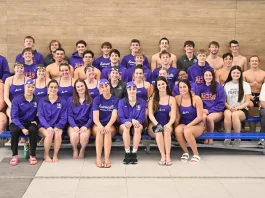Technology found a way.
So did silliness.
Even amid pandemic separation, Indiana’s powerhouse swim team connects in a way that makes a difference now, and, hopefully, when the college sports world returns to normal.
“We just did our first Zoom team meeting on Wednesday,†swim coach Ray Looze says. “I thought that went pretty well. It was good for everybody to see each other.â€
He pauses as the coach in him surfaces.
“The level of maturity wasn’t the best. You had some clown making faces, making everybody laugh.â€
And then came perspective in a time when laughter is so often needed.
“It was positive to see each other.â€
Finding the positive is among the goals facing Looze and his staff as they strive to make the best of a tough situation, aim to sustain the work and preparation that has made the program a national men’s and women’s title contender for so long (nine Big Ten championships in Looze’s 18 IU seasons).
“We talked about what we’re going to do,†he says. “We’ll have weekly team meetings. We can operate, from an NCAA standpoint, eight hours a week. We’ll do some education, some film sessions.
“We’ll figure out how to do that on Zoom. We’ll do some team-building exercises. At least we’ll keep their minds sharp and thinking about technique, so when our bodies return to the pool, it will help ready us.â€
Readiness will come remotely for the foreseeable future.
“By NCAA rule,†Looze says, “no varsity swimmer can be coached or trained. We can’t have anything to do with those athletes.
“Our kids are scattered throughout the country and the world. Maybe a couple have any access to private pools. They’re doing stuff on their own.â€
In these Covid-19 times, runners run, football and baseball players throw and catch, but for swimmers, well, it gets complicated.
“We post a daily practice on our TeamWorks account,†Looze says, “but 98 percent of our student-athletes just don’t have access to a pool, due to the unique nature of our sport.â€
Basically all public and university owned pools across the country, if not the world, are closed. That leaves privately owned pools, and few of those in the Bloomington area are set up for elite-swimmer use.
“Bloomington is such a small community,†Looze says. “We don’t have things like that here. I check with realtors to see what is the largest pool they know of in somebody’s home, inside or outdoor, and if it’s heated. We struck out everywhere in and around Bloomington.
“A lot of times a pool is 14 yards across. You take two strokes and it’s not doable. You could only fit one kid in there safely.â€
For the few pools that are available, Looze adds, “They find us.â€
So how do you train swimmers in such conditions?
“We had a staff meeting and brain-stormed on that this week,†Looze says. “Our weight coaches are putting up a generalized program they can access and do on their own, but that’s getting stale quick.
“Our weight coaches are doing the best they can. Typically you have all sorts of things going on as far as workouts from distance swimmers to sprinters. This general thing has been okay, but we’re thinking of ways to do specific work.â€
IU might resort to old-school training methods unique to swimming.
“I talked to our soccer coach (Todd Yeagley) and we’re going to see if we’re able to send some equipment home to our student-athletes,†Looze says. “I have to check with compliance.
“In swimming, there are a lot of arm land cords you can us. When I was a student-athlete (an All-American at Southern California in the late 1980s), I used to do a lot of this stuff — you attach it to railings or benches. If that’s permissible, we’ll send that stuff home and give them a program they can do.â€
Eventually the weather will warm up enough for lake — or even river — swimming. Some East and West Coast swimmers have already hit the ocean.
“We’re looking at getting some wet suits from Speedo to swim on lakes on their own now and not have to wait until May,†Looze says. “I saw some kids in California were swimming in the ocean in wet suits. That’s another possibility we’ve talked about.
“A lot of kids are cycling. That’s where we’re at today.â€
IU is still dealing with the disappointment of last month’s stunning end to the season.
For the men, the No. 4 Hoosiers had finished third in the Big Ten meet and, with 11 athletes qualified for the NCAA Championships in Indianapolis, were aiming for their third straight top-three national finish.
For the No. 23 women’s squad that also placed third in the Big Ten meet, 10 swimmers advanced to nationals. IU was positioned for a sixth straight top-10 national finish.
They never got the chance.
“You have (the NCAA meet) canceled one day,†Looze says. “Maybe we had one more practice and then they closed the pool and sent everybody home. This happened in a matter of days. Not only had we just lost our championship, but we were ripped out of our schools, then scattered.â€
As for what happens to the out-going seniors, Looze says, “Most of them have decided to retire,†including honorable mention All-American Cassy Jernberg and All-American Shelby Koontz.
“It depends on where you are academically and if you want to go to grad school. I’ve talked to a lot of coaches on how to counsel kids on that.
“If you have a chance to make an A Final (in a national meet), there’s an argument to be made, but if not …
“I’m a big believer in moving on in life. If you’ve done what you can in your sport, don’t hang on just to hang on, but ultimately it’s up to them.
“It’s a bummer for how it ended for the seniors, but life’s not fair. This is something bigger than anybody could have imagined, and continues to get bigger. Missing a meet is such a minor thing when you’re watching things unfold as they are.â€



